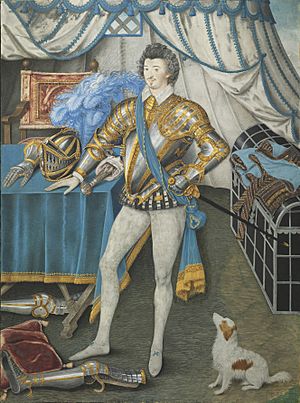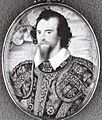Greenwich armour facts for kids
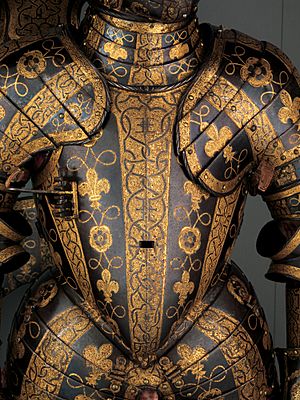
Greenwich armour was a special type of plate armour made in England. It had its own unique style. This armour was created at the Royal Armoury, which was started by Henry VIII in 1511. The workshop was located in Greenwich, near London. It kept making armour until the English Civil War began.
King Henry VIII brought in skilled armour makers from other countries to start the workshop. These included experts from Italy, Flanders, and Germany. The German armourers were the most important for much of the 1500s.
The most famous master armourer at Greenwich was Jacob Halder. He led the workshop from 1576 to 1607. This was when the armoury made its most beautiful pieces. These armours often had fancy gilding (gold decoration) and bright colours. They matched the detailed styles of late Tudor England.
By the late 1500s, full plate armour was not used as much in real battles. So, Greenwich armours were mostly made for tournaments, not for war. Jousting was a favorite sport of Henry VIII. His daughter, Elizabeth I, made her "Accession Day tilts" (jousting events) a big part of court life. These events were a way for courtiers (people at court) to show their loyalty to the Queen. Even when she was older, courtiers would take part to gain her favor.
The Greenwich workshop made custom armour for important noble families. Most of the armour for the army was made elsewhere. A special book of Greenwich armour designs, called the "Jacob Album," shows armours for 24 different gentlemen. Many of these were very important people in Elizabeth's court. During this time, the Greenwich style became very unique. It copied popular clothing styles and used lots of gold and bright colours. The designs were often complex and artistic.
By the mid-1600s, plate armour looked much simpler. It was made thicker to protect against powerful firearms, which were changing how battles were fought. After this, armour almost completely disappeared. So, the Greenwich workshop was the last place in England to make such decorative armour. It created a special kind of art from the late Renaissance.
Contents
What Makes Greenwich Armour Special?
Early Greenwich Armour (Henry VIII's Time)
Before 1511, there were English armour makers. They even had their own guild (a group of skilled workers) in London. However, they could not make large amounts of armour. They also struggled to create the best quality or the newest styles found in Europe.
In 1511, Italian armourers were hired at Greenwich. They were paid and given wine. Records show that tools and a mill were bought to set up the workshop. Greenwich Palace was an important royal home. Both Henry VIII and his two daughters were born there. By 1515, there were six German master armourers. There were also two Flemish masters, two polishers, and an apprentice. They all worked under the King's Armourer, John Blewbury. Everyone was given special damask clothing.
In 1516, the workshop moved to a mill in Southwark. This was closer to London but still outside the city. This helped avoid rules from city guilds. A new mill was built at Greenwich. When it was finished in 1520, the workshop moved back to Greenwich.
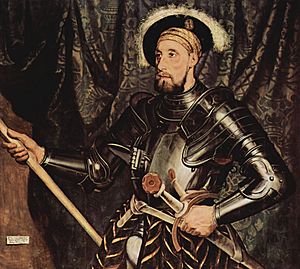
The first Greenwich armours, made for Henry VIII, usually had one colour all over. They were either gilded (covered in gold) or silvered. Then, they were etched with detailed patterns. These designs were often made by Hans Holbein the Younger. The shape of these armours was similar to German designs of that time. However, the decorations were often much more elaborate.
A good example is an armour thought to belong to Galiot de Genouillac. It was first made for King Henry. This armour is now at the Metropolitan Museum of Art in New York. It has a special support built into the chest piece (cuirass) to fit the king's large size. This armour also has very wide foot coverings (sabatons), like the Maximilian armour style. Another similar armour, but without gold, was also made for Henry VIII. It is now at the Tower of London and is known for its large codpiece.
The Golden Age of Greenwich Armour
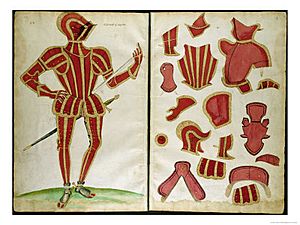
After Henry VIII's reign, Greenwich armour changed. It developed its own unique style. The second wave of armour had several key features. One was that the armour copied popular clothing styles of the time. This showed the wearer's taste in everyday clothes.
From 1560, the chest pieces (cuirasses) were shaped to look like the "peascod" style of doublet. This was a very popular jacket for gentlemen during Queen Elizabeth's reign. This type of cuirass curved outwards sharply at the front.
Instead of being all gold or silver, the armours now had strips of blued (dark blue) or gilded steel. These strips usually ran across the shoulder pieces (pauldrons) and down the chest and thigh guards (tassets). This copied the colourful embroidered cloth strips popular in civilian fashion.
Some armours came with an extra pair of very wide tassets. These were used for fighting at the barriers (a type of tournament). They looked like a type of puffy shorts called trunkhose. The armours of Robert Dudley, 1st Earl of Leicester, and Henry Herbert, 2nd Earl of Pembroke, still show these wide tassets. The armour of William Somerset, 3rd Earl of Worcester, has a similar style.
Another key feature of Elizabethan Greenwich armour was the huge use of colour. Older armour styles, like Maximilian armour and Gothic plate armour, focused on shaping the metal itself. They used fluting (grooves) and roping (twisted edges) to create designs. But the Greenwich style came at a time when detailed decoration with colour, texture, and raised designs was popular across Europe.
Greenwich did not make armours with highly shaped figures like some European workshops. Instead, it focused on bold designs using different colours. This created bright, striking patterns. Colour contrast became very important, just like in civilian fashion. How much an armour was decorated depended on how rich the buyer was. Some pieces were very elaborate and artistic, like George Clifford's famous gold armour. Others were simpler "white armour" with crisscrossing patterns of darker strips. In both cases, using contrasting colours was a sign of the Greenwich style.
There were three main ways to colour the steel: bluing, browning, and russeting.
- Bluing gave the steel a deep, shiny blue-black finish.
- Browning made the steel a dark brown. This looked very striking with gold, as seen on the armour of George Clifford, 3rd Earl of Cumberland.
- Russeting gave the steel a dark-red or purple colour. This was also usually used with gold.
These base colours were put evenly on the steel. Then, strips of different coloured steel were added to make patterns. Or, etched parts of the armour were gilded. The Earl of Worcester's armour is a great example. It had a scalloped design that was originally gilded over dark blued steel.
The Greenwich helmet for battle and jousting had a special shape. A typical Greenwich helmet was an armet with a very tall visor. This visor had vertical slits for field use or small round holes for jousting. The bottom edge of the upper visor stuck out gracefully, making the helmet look like a "ship's prow." It also usually had a high raised comb from the back of the head up to the top of the visor. This feature was influenced by French styles.
Finally, Greenwich armours were often made as a garniture. This was a large set of interchangeable armour pieces. These "pieces of exchange" had the same design. They could be put together to form a suit for mounted combat (like jousting) or fighting on foot in a tournament. A garniture usually included a full plate armour suit. It also had an extra visor for jousting, a burgonet helmet (worn open for parades or with a removable visor for combat), a grandguard (to protect the upper body for jousting), a passguard (to protect the arm), and a manifer (a large glove to protect the hand). It might also include a shaffron (for the horse's head) and decorated saddle steels.
Later Greenwich Armour (Stuart Period)
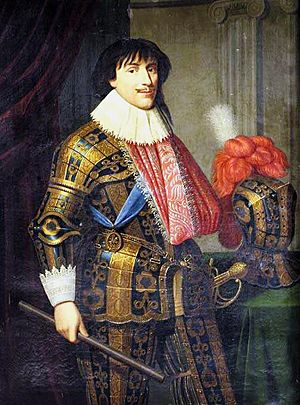
The Greenwich workshop kept making armours during the reigns of James I and Charles I. However, the grand tournaments and chivalric shows of Elizabethan England mostly ended after the death of Henry Frederick, Prince of Wales. This change can be seen in the style of later Greenwich armour. Gold decoration and etching were gone. The steel was no longer russeted, polished "white," or brightly coloured. It was just a simple blue-gray shade.
The thigh guards (tassets) often reached the knee, like those worn by cuirassiers (heavy cavalry). Also, to improve protection, the inner elbows were often fully covered by moving plates (lames). Even during the English Civil War, Greenwich armours kept some of their unique touches from the past century. The breastplates still had the "peascod" shape. The shoulder pieces (pauldrons) had the same graceful, rounded curves. (Armours from other European countries often had more square shapes.) The "ship's prow" shape of the helmet also remained. You can see it in many paintings of important military leaders from the English Civil War.

The Jacob Album: A Design Book

An album, now in the Victoria and Albert Museum, was created by Jacob Halder. It has full-colour pictures of 29 different Greenwich armours. These were made for various important Elizabethan gentlemen. Many of these armours were part of large "garnitures," with extra pieces also shown. The album shows each customer standing in the same pose. They have their right hand on their hip and their left hand holding a staff. They are wearing the armour that was made for them.
The people shown in the album include some of the most famous and powerful nobles in Queen Elizabeth's court. Among them are:
- Robert Dudley, 1st Earl of Leicester
- William Herbert, 1st Earl of Pembroke
- Sir Thomas Bromley, who was the Lord Chancellor of England (a very important legal official)
- Sir Christopher Hatton, who took over from Bromley as Lord Chancellor
- Sir Henry Lee, Queen Elizabeth's first official jousting champion
- George Clifford, 3rd Earl of Cumberland, the Queen's second official champion. He was also an important naval commander.

Other notable people whose armours are in the album include Thomas Sackville, 1st Earl of Dorset. He was the Lord High Treasurer (in charge of the country's money). Also, Sir James Scudamore, a jousting champion. He was the inspiration for a character in the famous poem The Fairie Queene. One armour in the album is for "John, Duke of Finland." This was the future king John III of Sweden. He visited England in 1560.
Another design is for a man named Bale Desena. His identity is still a mystery. He was likely not English, as his name sounds Spanish or Italian. It is not known how he ordered a Greenwich armour. Sometimes, these armours were given as gifts to foreigners. For example, Christian of Brunswick, a friend of Henry Frederick, Prince of Wales, received a gilded Greenwich armour.
Twenty-three of the 29 armours in the album belong to different people. Robert Dudley, Christopher Hatton, and Henry Lee each had two suits of armour. This was probably because they were favorites of Queen Elizabeth. Many of the armours shown in this album still exist today. The armours of Robert Dudley, William Somerset, and William Herbert are at the Royal Armouries at the Tower of London. Christopher Hatton's armour is at the Royal Armouries gallery in Leeds.
The complete armour set of George Clifford is on display at the Metropolitan Museum of Art in New York. The armours of Sir James Scudamore and Henry Herbert, 2nd Earl of Pembroke are also there.
When compared to the real armours, the drawings in Jacob Halder's album are almost exact copies. There is only one main difference. The drawing for William Somerset's armour shows a deep red background with gold bands. But a painting of the Earl clearly shows a black background. Other than that, the design matches the armour perfectly.
Several of the armour sets in the album have the same design. This design has gold bands in a snaking S-shape pattern. It also has crisscrossing diagonal lines in an X pattern. This is sometimes said to look like lightning. All of this is over a background of deep purple-red steel. The armours with this design belong to Sir James Scudamore, William Compton, 1st Earl of Northampton, and Thomas Sackville.
However, when comparing the drawings to the real armours, some small details are different. For example, the number of plates (lames) in a piece might not match. This might mean that the armour makers had some freedom to improve the designs as they worked.
Images for kids
-
The same armour of William Somerset as it originally appeared
-
Armour of Thomas Sackville, 1st Earl of Dorset, Jacob Halder, c. 1587–1589
-
Greenwich armour of Sir James Scudamore, 1590s. Jousting was crucial to Scudamore's reputation at court.
-
George Clifford wearing the armour shown at top
-
Sir Kenelm Digby


